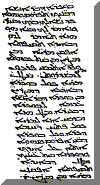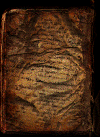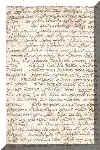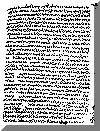Little help with history of Syriac please
I was recently studying Luke 1:28, and discovered the end of the verse "Blessed are you among women" was not in the earliest manuscripts. To cut a long story short, I eventually turned to Metzger's Textual Commentary:
Although many witnesses (including A C D Θ and most minuscules, followed by the Textus Receptus) read after σοῦ the words εὐλογημένη σὺ ἐν γυναιξίν, it is probable that copyists inserted them here from ver. 42, where they are firmly attested. If the clause had been original in the present verse, there is no adequate reason why it should have been omitted from a wide diversity of early witnesses (including א B L W Ψ f 565 700 1241 syrpal copsa, arm geo al).
My question refers to the syrpal . The superscripted tag reads:
syrpal (Lewis/Gibson, Palestinian Syriac Texts; and others). Palestinian Syriac, from about the sixth century.
So this means even in the Eastern textual history this addition had not appeared by the 6th century. So far - so good.
However, when I checked The Syriac New Testament: Translated into English from the Syriac Peshitto Version, it had made it's way into the Eastern tradition. Interestingly, not into the Sahidic or Bohairic Coptic, so it was not the norm for the Orthodox church.
I can understand the Vulgate and it's theological implications for having this verse included... my question is... why do you think it was eventually included in the Peshitto? And does anyone know the dates of the Peshitto texts? Could you point me to any reading on the progression from the 6th Century Syriac text to the Peshitto?
I'm really hoping I have not embarrassed myself as I have no theological training or background in textual criticism... just an interested layman.
Comments
-
Is Mebin said:
However, when I checked The Syriac New Testament: Translated into English from the Syriac Peshitto Version, it had made it's way into the Eastern tradition. Interestingly, not into the Sahidic or Bohairic Coptic, so it was not the norm for the Orthodox church.
If you make the split - Western, Byzantine, Eastern Church - what is shown is that it was not the norm for the Eastern (Assyrian) Church. It doesn't say anything about the Byzantine/Orthodox Church.
I'd Google Peshitta Institute and see if they provide manuscript info.
Orthodox Bishop Alfeyev: "To be a theologian means to have experience of a personal encounter with God through prayer and worship."; Orthodox proverb: "We know where the Church is, we do not know where it is not."
0 -
I have no knowledge of Syriac Textual Criticism, but thought I'd use Logos to try and answer the question. The only useful result (apart from the critical apparatus) was from an article in JBL on Tatian's Diatesseron:
In the very numerous cases where a verse is not quoted in Ephraem’s Commentary, the importance, for Diatessaron research, of the Old Syriac and Peshitta versions of the Gospels and the Arabic and Persian harmonies comes to the fore (see below sections 2 and 4). A reading can often be designated Tatianic if it is attested by the Old Syriac, because that version is dependent on the oldest known Syriac Gospel text, Tatian’s Diatessaron. But the later Peshitta Syriac version also contains Tatianic readings. This is established by the fact that, when the Arabic Diatessaron (sometimes along with the Persian Harmony) and the Peshitta agree, they are very often joined by the Old Syriac, so that the reading in question is older than the Peshitta and could be Tatianic. Therefore, where the Old Syriac is missing altogether, as in Luke 1:16–38, the Peshitta may again retain older, Tatianic readings. The other witnesses described in the sections that follow contribute, to a greater or lesser degree, to a decision about whether a reading is Tatianic or not.1 The most important are the Armenian, Georgian, and Old Latin versions; the Liège (Dutch) Diatessaron; and Greek manuscripts uninfluenced by the Peshitta, for example, DWΘ.
Footnote 1 adds: "In a review of B. M. Metzger, The Early Versions of the New Testament (Oxford Clarendon, 1977; see section 2 below), G. D. Kilpatrick denies that there is any firm evidence for the existence of a Tatianic text as such; rather, “as circumstances required one text was substituted for another: in the West the Vulgate replaced the Old Latin and in the East the Peshitta took the place of a pre-Peshitta text.” He therefore thinks “Tatianisms” in the various sources may be a delusion (ExpTim 89 [1978] 185)."
You can read about the Diatessaron here: http://en.wikipedia.org/wiki/Diatessaron (or there's stuff in Logos, obviously).
This is my personal Faithlife account. On 1 March 2022, I started working for Faithlife, and have a new 'official' user account. Posts on this account shouldn't be taken as official Faithlife views!
0 -
I assume you read the article in Anchor Yale, which is fairly extensive.
Personally, having spent the last few weeks going through Matthew and just comparing the major early versions, I'm less inclined to respect a lot of the greek version reasoning. That is not to imply my unbelievable wisdom; rather in the absence of much of anything solid, their reasoning still proceeds apace on very thin breadcrumbs (since they DO have to make a decision).
Plus, of course, that phrase can be read two ways.
"If myth is ideology in narrative form, then scholarship is myth with footnotes." B. Lincolm 1999.
0 -
MJ. Smith said:
If you make the split - Western, Byzantine, Eastern Church - what is shown is that it was not the norm for the Eastern (Assyrian) Church. It doesn't say anything about the Byzantine/Orthodox Church.
Thank you MJ for that distinction - that is really helpful. I'm really not up to speed on the different textual traditions and how they relate to the differing streams of Christianity... so this is why I asked... not that I want to delve into textual criticism as a discipline, but having a knowledge of the textual traditions is of utmost importance in such verses as Lk 1:28. I wish this was taught in New Christians classes...lol!
0 -
Mark Barnes said:
Therefore, where the Old Syriac is missing altogether, as in Luke 1:16–38, the Peshitta may again retain older, Tatianic readings.
Awesome research skills buddy... and thanks, that is very enlightening to the topic at hand. I have only been using L4 for 2 years now, and my library is 'reasonable', but have not invested in any journals yet[:(]. I will have to look out for some specials!
Mark Barnes said:“as circumstances required one text was substituted for another: in the West the Vulgate replaced the Old Latin and in the East the Peshitta took the place of a pre-Peshitta text.”
It's going to take some time I expect to get my head around all this... but this is all very helpful... thank you.
0 -
Sorry, no. I was tossing up whether to get AYB and AYBD on a plan during this Christmas sale period, but opted for the Hebrew Bible Bundle and the Early Judaism Bundle instead. Anchor is on my list to get, but it will be twelve months away now.Denise Barnhart said:I assume you read the article in Anchor Yale, which is fairly extensive.
Denise Barnhart said:Plus, of course, that phrase can be read two ways.
C'mon DB, don't hold out on me now... please expand. For a question that I would have loved your personal e-mail to send you it directly, you are teasing...lol!
Denise Barnhart said:comparing the major early versions
Do you use L4 for this? Aside from opening up a text comparison panel and having NA27, with Scriveners, Byzantine and Logos (Westcott and Hort) I don't know how to go any further. I so wish we had digitized copies of the manuscripts, fully linked in L4.
Denise Barnhart said:I'm less inclined to respect a lot of the greek version reasoning
Denise Barnhart said:their reasoning still proceeds apace on very thin breadcrumbs (since they DO have to make a decision)
Sorry, I know you are referring to those who have "Greek version reasoning", but who are you directly referring to?
Where are you getting all your info from? Where should I be reading?
You have been entrusted with such great knowledge, now teeeeeaaaachhhhh me...lol!
0 -
Is ... I am no expert (though I DO wish some of the experts on the forum would speak up more).
Concerning versions, I keep a window of 3 syriacs (the gospels, Peshitta-NT, Diatesseron), 2 coptics (Sahidic, Bohairic), 1 latin (Vulgate), and 2 greek eclectics (NA27 and Newberry/Literal) open. All of these are available from Logos and all in english. I also keep some normal english literals open too (YLT, etc).
Of course, they're ALL summations of earlier versions and they're ALL arguable as to their dating. But by simple comparison they do operate similar to the canary in the mineshaft, when you see differences, suggesting to dig deeper. I literally go verse by verse, watching where the differences occur and seeing what the pattern is. The key principle that is so true, is that religious people don't accidentally use words. If it's different, there's a reason. The 'copyist' should be the last choice.
My comment on the greek comes from having spent time comparing the syriacs, and having already analyzed the the major greek text forms mathematically. Much of the 'confident' language (when the manuscripts are almost a toss-up) is an over-reach. But that's a personal opinion. I think very often the correct answer is 'really don't know'.
Regarding 'Mary', I'd just watched a TV show on a series of monestaries in Greece where women and children were prohibited, since they detracted from the true Jesus (their quote). Then reading the phrase you mentioned, I could easily see how one could let it disappear (versus be added).
Lastly regarding manuscript series, as far as I know Logos doesn't really have a good source on tracking back the manuscripts, along with the pluses / minuses. I personally like Aland's book, Westcott and Erhman (the one on post-1st century changes).
"If myth is ideology in narrative form, then scholarship is myth with footnotes." B. Lincolm 1999.
0 -
Is Mebin said:
And does anyone know the dates of the Peshitto texts? Could you point me to any reading on the progression from the 6th Century Syriac text to the Peshitto?
There are articles on the Peshitta in most decent Bible dictionaries, but there's no consensus that I can see. For example, the DNTB dates them to the fourth century and says they have no direct relationship to the Old Syriac Gospels. But AYBD says early 5th century, and was a revision of the Old Syriac!
This is my personal Faithlife account. On 1 March 2022, I started working for Faithlife, and have a new 'official' user account. Posts on this account shouldn't be taken as official Faithlife views!
0 -
History of the Peshitta

The Peshitta is the official Bible of the Church
of the East. The name Peshitta in Aramaic means "Straight",
in other words, the original and pure New Testament. The Peshitta is the
only authentic and pure text which contains the books in the New Testament that
were written in Aramaic, the Language
of Mshikha (the Messiah) and His Disciples.In reference to the originality of the Peshitta, the words of His Holiness
Mar Eshai Shimun, Catholicos Patriarch of the Church of the East, are summarized
as follows:"With reference to....the originality of the Peshitta text, as the
Patriarch and Head of the Holy Apostolic and Catholic Church of the East, we
wish to state, that the Church of the East received the scriptures from the
hands of the blessed Apostles themselves in the Aramaic original, the language
spoken by our Lord Jesus Christ Himself, and that the Peshitta is the text of
the Church of the East which has come down from the Biblical times without
any change or revision."Mar Eshai Shimun
by Grace, Catholicos Patriarch of the East
April 5, 1957
Folio 154 verso of Sinai Syriac 2
(Peshitta, V century), John 17:7-17.
Thanks to Jean Valentin.Peshitta New
Testament Ms. Variously identified as
6th or 7th Century.In reference to Aramaic, the Latin Patriarch Maximus at
Vatican II, stated:"Christ, after all spoke in the language of His
contemporaries. He offered the first sacrifice of the Eucharist in
Aramaic, a language understood by all the people who heard Him. The
Apostles and Disciples did the same and never in a
language other than that of the gathered faithful."Codex Ambrosianus - 5th Century
Ambrosian Library, Milan, Italy.
Thanks to Alan Aldawood.These are claims that are highly contested in Western
Christianity. The common misconception that the New Testament was
originally penned in Greek still persists today in a vast majority of Christian
denominations. Most scholars and theologians acknowledge that Eshoo
Mshikha, the Apostles, and the Jews in general spoke Aramaic indeed many
instances of Aramaic survive in the Greek New testament manuscripts.
However, they still maintain that the New Testament was penned in Greek by the
Apostles and disciples of Mshikha.Aramaic Lectionary - about
A.D. 550. Pierpont Morgan Library
New York, N.Y.The Church of the East has always rejected this claim.
We believe that the Books of the New Testament were originally penned in
Aramaic, and later translated into Greek by first-century Gentile Christians in
the West, but never in the East, where the Aramaic was the Lingua Franca of the
Persian Empire. We also hold and maintain that after the books were
translated into Greek, the Aramaic originals were discarded, for by now the
Church in the West was almost completely Gentile and Greek-speaking. This
was not the case in the East, which had a Jewish majority (especially in Babylon
and Adiabene) for a much longer period. Even when the Church of the East
became mostly Gentile, the Aramaic was preserved and used rather than translated
into the various vernacular languages of the regions to the East of the
Euphrates river.Peshitta
Old Testament MS. - A.D. 464. Oldest dated
Biblical Manuscript in existence. British Museum, Add. Ms. 14,425.
Thanks to Alan Aldawood.Peshitta MS.
(Exodus. xiii. 14-16)--A. D. 464.
(British Museum, Add. MS. 14; 425.)Four books or the Pentateuch, viz:
Genesis, Exodus, Numbers, and Deuteronomy according to the Peshitta version, in
the Estrangela characters. Written in the city of Amid, Assyria A. D. 464:
the oldest dated Biblical manuscript in existence. From the monastery of St.
Mary Deiyara in the Nitrian Desert of Egypt.Even to the West of the Euphrates river, in the Holy Land,
the main vernacular was Aramaic. The weekly synagogue lections, called
sidra or parashah, with the haphtarah, were accompanied by an oral Aramaic
translation, according to fixed traditions. A number of Targumim in
Aramaic were thus eventually committed to writing, some of which are of
unofficial character, and of considerable antiquity. The Gemara of the
Jerusalem Talmud was written in Aramaic, and received its definitive form in
the 5th century. The Babylonian Talmud with its commentaries on only 36
of the Mishnah's 63 tractates, is four times as long as the Jerusalem
Talmud. These Gemaroth with much other material were gathered together
toward the end of the 5th century, and are in Aramaic. Since 1947,
approximately 500 documents were discovered in eleven caves of Wadi Qumran near
the northwestern shore of the Dead Sea. In addition to the scrolls and
fragments in Hebrew, there are portions and fragments of scrolls in
Aramaic. Hebrew and Aramaic, which are sister languages, have always
remained the most distinctive features marking Jewish and Eastern Christian
religious and cultural life, even to our present time.Khaboris Manuscript. 4th
Century A.D. Hakkari mountains
(Khda'Yab,
"Adiabene"), Assyria.
Readings from the Book of Matti in
the Khaboris Manuscript.The Aramaic in
which the Bible called "Assakhta Peshitta" is written, known as the
Peshitta Text, is in the dialect of northwest Mesopotamia as it evolved and was
highly perfected in Orhai, once a city-kingdom, later called Edessa by the
Greeks, and now called Urfa in Turkey. Harran, the city of Abraham's
brother Nahor, lies 38 kilometers southeast of Orhai. The large colony of
Orhai Jews, and the Jewish colonies in Assyria in the kingdom of Adiabene whose
royal house had converted to Judaism, possessed most of the Bible in this
dialect, the Peshitta Tenakh. This version was taken over by all the
Churches in the East, which used, and still use Aramaic, as far as India, and
formerly in Turkestan and China. The Peshitta Tenakh was completed during
Apostolic times with the writings of the New Testament.Sample page from an Aramaic
manuscript in Estrangelo script (Beginning of 6th century AD)For this diglot, I am using the Church of the East
text of
the Peshitta, in which I will be following the oriental sequence of the
books,
which places the General Epistles (Yaqub, Keepa and Yukhanan)
immediately after the
Acts of the Apostles, and before the Epistles of Sha'ul (Paul). The
Peshitta does not contain four of the General Epistles (2 Keepa, 2
Yukhanan, 3
Yukhanan and Yehuda), the book of Revelation, nor the story of the
woman taken in
adultery (Yukhanan 8.) These writings are not considered canonical by
the
Church of the East, and have never been included in the the Canon of the
Peshitta. The script used will be the original Estrangela, without
vowel markings that were introduced during the 5th century.Paul D. Younan
06/01/2000
http://www.peshitta.org/initial/peshitta.html
P.S. I do not necessarily agree with the above but it seems as though we needed a voice that actually used the Peshitta rather than treating it as a foreign object.
Orthodox Bishop Alfeyev: "To be a theologian means to have experience of a personal encounter with God through prayer and worship."; Orthodox proverb: "We know where the Church is, we do not know where it is not."
0 -
Denise Barnhart said:
Then reading the phrase you mentioned, I could easily see how one could let it disappear (versus be added).
Oh, I understand your point now.
Denise Barnhart said:as far as I know Logos doesn't really have a good source on tracking back the manuscripts,
I hope this is an area of concentration in the future, even in conjunction with CSNTM. But even on that site, most of the manuscripts are not available for perusal.
Denise Barnhart said:I personally like Aland's book, Westcott and Erhman (the one on post-1st century changes).
Yes, I've got some books on the subject... but really need to read wider to understand the different textual history (or families) more fully... in order to apply it to the particular verse or passage I'm studying at that time.
In this case (Luke 1:28) I could not find a logical conclusion (in my mind) why the verse is in "The Syriac New Testament: Translated into English from the Syriac Peshitto Version", and is actually present in the "Diatesseron" (2nd century?), but not in the Palestinian Syriac 6th century texts mentioned by Metzger. Are those of the 6th century older than "The Old Syriac Gospels Studies and Comparative Translations"? It is all a little confusing... but worth the digging I feel.
Thank you for the help thus far... I just find it all fascinating... and there's no use having such resources in L4 if I don't try to use them...lol!
0 -
Mark Barnes said:
There are articles on the Peshitta in most decent Bible dictionaries, but there's no consensus that I can see. For example, the DNTB dates them to the fourth century and says they have no direct relationship to the Old Syriac Gospels. But AYBD says early 5th century, and was a revision of the Old Syriac!
Yeah mate, it's a little confusing... thanks again. I can't believe one comment by one of our Pastor's in the context of a Christmas message could spark such intrigue within me...lol!
0 -
MJ. Smith said:
the Church of the East received the scriptures from the
hands of the blessed Apostles themselves in the Aramaic original, the language
spoken by our Lord Jesus Christ Himself, and that the Peshitta is the text of
the Church of the East which has come down from the Biblical times without
any change or revision.Wow, even if we accepted the concept of Aramaic originals... this still sounds to me a plea for authority... you know, we are the ones that are right... the trail of blood, so to speak... especially to claim the Eastern Church have not only the originals, but without any change or revision. I think even the differences in the Syriac manuscripts prove this to be along the lines of KJVonly-ism (is that a word).
MJ. Smith said:I do not necessarily agree with the above but it seems as though we needed a voice that actually used the Peshitta rather than treating it as a foreign object.
Yes... and I pray we never treat any of the Scriptural witnesses with such contempt... we have a lot to be thankful for in the many thousands of Latin manuscripts (not that I personally have accessed them)... not only our Greek testimonies so heavily relied upon in modern scholarship. Any surviving manuscripts of the Scriptures, no matter what language or textual family, should be discussed in scholarly settings with an openness, not from personal theological biases, but from the light of history and how the Scriptures we have today have been preserved within many differing cultures and contexts.
Thank you for your input MJ - I really appreciate it.
0 -
The history of the Peshitta translation of the New Testament is complex and debated vigorously within the academy. Suffice it to say that the Peshitta was a process and not an event and finally coalesced, in the form in which we received, around the beginning of the 6th C. There were earlier Syriac translations, the Old Syriac Gospels and Tatian's Diatesseron at the minimum. But while they influenced the Peshitta translation it is unknown to what extent they did influence the Peshitta translation. The history of the Old Syriac translations is even murkier. Tatian's Gospel harmonization can be safely dated to the mid-late 2nd C. However, with a likely Syriac/Aramaic original for the Odes of Solomon and the Gospel of Thomas, it is not unreasonable to presume that an Aramaic or Syriac translation, of at least the Gospels, was completed even earlier than this, but this particular line of reasoning is supposition.
Probably the best sources of information about the Syriac texts in Logos is:
The Bible in the Syriac Tradition by Sebastian Brock.
Unfortunately we only have the Syriac translation and not the English original in Logos. (Logos, please try and get electronic publishing rights to this work, while I read Syriac I do not read it that well [:D] ).
Other sources in Logos:
The Syriac language of the Peshitta and Old Syriac versions of Matthew by Jan Joosten.
Synbols of Church and Kingdom by Robert Murray.
And dealing more with the Old Testament Peshitta (an even murkier translation process):
The Peshitta of Daniel by Richard Taylor.
0








